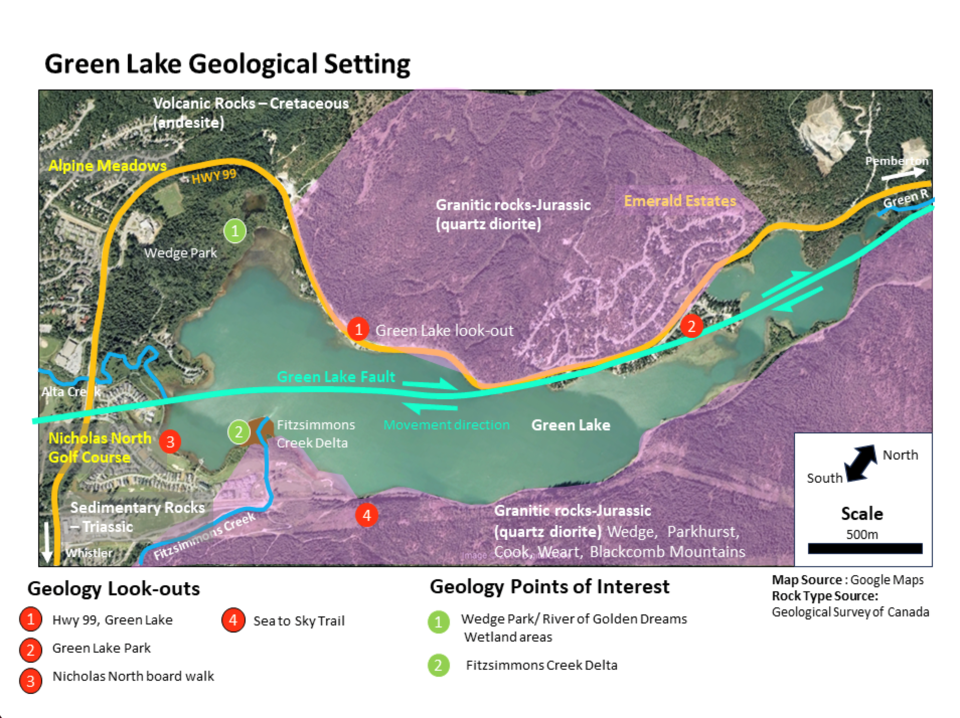It’s a great time to get outside and check out the amazing geology on our doorstep; towering granitic peaks, iconic volcanoes, glaciers and massive landslides. If you are not sure where to start over the next few months, I will highlight some of the great geological sites you may want to explore around Whistler.
First up is Green Lake. Whistler’s most northerly, largest, deepest and arguably most beautiful lake, there is so much to see and great access to viewing points and geologically interesting locations. A good place to start your adventure is 6.7 kilometres north of Whistler Village, on the east side of Highway 99 at the Green Lake viewing pull-in. Here you get terrific views of the Coast Mountains, one of the world’s iconic mountain belts and the largest granitic body in North America. These mountains are associated with a chain of converging tectonic plate boundaries called the Pacific Ring of Fire, where many of the world’s major mountain ranges, volcanoes and earthquakes occur.
About 80 per cent of the Coast Mountains are light-coloured granitic rocks like quartz diorite, which form Blackcomb, Wedge, Weart, and Cook mountains. Mount Currie to the north has some darker-coloured granitic rock, diorite. These rocks formed about 150 million years ago as “plutons” of hot molten magma moved up through the Earth’s crust before cooling underground and crystallizing as solid granite.
Whistler Mountain to the south is about 80 million years old, and comprises sedimentary (shale and silt) and volcanic rocks, which were thrust up along the Fitzsimmons Range Fault located high up on the north side of Whistler Mountain. Much of the underlying bedrock around the west/south of Green Lake is also of sedimentary and volcanic origin.
The towering Coast Mountains are impressive today, but that wasn’t always the case. About 15 million years ago, erosional forces had worn down the mountains into a landscape of gentle, low-rolling hills. Most precipitation bypassed this area and fell further inland. Then, about 10 million years ago, the mountains were forced upwards by tectonic activity, blocking the path of moist, oceanic air. This resulted in increased precipitation on the Coast Mountains, and produced a rain shadow and arid conditions inland in the Okanagan. Whistler undoubtedly greatly benefited from this period of mountain building, especially via the winter pow and B.C. wines.
The compressive forces that helped form the Coast Mountains also played a part in forming the valley below. Sometime in the past 23 million years, a 20-km-long, northeast-southwest trending tear occurred in the Earth’s crust known as the Green Lake Fault. Bedrock on the east side of the fault (including those underlying Wedge, Blackcomb, and Whistler mountains) moved several kilometres to the south, and the rocks on the west side moved north. Later, rivers followed this ancient fault line, initially cutting a V-shaped valley. In time, Ice Age glacial erosion widened and deepened the valley, leaving the broad, U-shaped valley, in which Green Lake sits today.
Stay tuned for Part 2 next month, when we will look at the effects of glaciation and the modern geological features of Green Lake.
Naturespeak is prepared by the Whistler Naturalists. To learn more about Whistler’s natural world, go to whistlernaturalists.ca.




